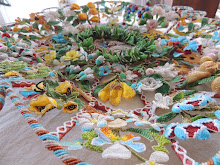
The above illustration is from an 1832 World of Fashion engraving, and shows the elaborate coiffures worn by the most fashionable women of the day. Hair was artistically arranged and piled and twisted around tall combs~ with the additions of flowers and 'bobbles', from the paintings and engravings I have seen, the comb was normally just visible from the rear. (I am speaking in reference to English, German, French and American wearers for now). Many German dolls from this period are referred to as 'Tuck Comb' dolls, as they were very plainly carved from wood with the exception of the large comb sticking up at the back of the head.
I have noticed an increased interest as of late, to the early 1830's dolls, Tuck Combs, Peg Woodens & Grodnertals....that I thought this post would be of liking to both my doll & Museum readers.
 As much as I love combs, I also love early boxes~ so I was literally as close as one could get to Heaven on Earth when this c1820-25 set came to live here at the Museum. Without it's contents, and label on the lid, this shape of box could be confused with similar of this crescent shape, that were made to hold men's uniform epaulets & regalia.
As much as I love combs, I also love early boxes~ so I was literally as close as one could get to Heaven on Earth when this c1820-25 set came to live here at the Museum. Without it's contents, and label on the lid, this shape of box could be confused with similar of this crescent shape, that were made to hold men's uniform epaulets & regalia. It measures a little over 9&1/2" wide, and is decorated with applied paper cut outs of star shapes and this wonderful GOAT on the front! The slightly metallic gold papers show signs of once having either painted on or engraved illustrations....long worn off over the years.....
It measures a little over 9&1/2" wide, and is decorated with applied paper cut outs of star shapes and this wonderful GOAT on the front! The slightly metallic gold papers show signs of once having either painted on or engraved illustrations....long worn off over the years..... On the lid of the box is the most wonderful label..........I'm always excited to see original labels! Roughly translated, cause my Spanish is not so good....it reads " Makers of Combs of All Types by Jose Hurtado, appointed by the Marquis, Malaga."
On the lid of the box is the most wonderful label..........I'm always excited to see original labels! Roughly translated, cause my Spanish is not so good....it reads " Makers of Combs of All Types by Jose Hurtado, appointed by the Marquis, Malaga." Malaga is located in Andalusia, the Southernmost region in Spain, and was, (and still is), known for its beautiful hair combs. Early Spanish women wore very tall combs at the back of the head, with very FLAT hair~ the comb was used to support a lace mantilla (veil). The taller the comb on your head, the higher you were in society. So along went our ancestors, off for a summer tour of Spain, and seeing these absolutely gorgeous combs, they brought them home and made their own tall fashions with them!
 Neatly inscribed in pencil inside the box lid reads ' Mifs Baistow~ Drefs Maker , ???? at her ??? Dennys~Salem St'. I cannot say weather this set was brought to Cape Cod as an import of fine European goods to offer for sale to her customers, or as a souvinir of her travels.....but in either case, it endured the 6+ mo boat trip across the Atlantic Ocean.
Neatly inscribed in pencil inside the box lid reads ' Mifs Baistow~ Drefs Maker , ???? at her ??? Dennys~Salem St'. I cannot say weather this set was brought to Cape Cod as an import of fine European goods to offer for sale to her customers, or as a souvinir of her travels.....but in either case, it endured the 6+ mo boat trip across the Atlantic Ocean.
 The box fits perfectly around its intended comb, and is no doubt responsible for its immaculate surviving condition
The box fits perfectly around its intended comb, and is no doubt responsible for its immaculate surviving condition

 Neatly inscribed in pencil inside the box lid reads ' Mifs Baistow~ Drefs Maker , ???? at her ??? Dennys~Salem St'. I cannot say weather this set was brought to Cape Cod as an import of fine European goods to offer for sale to her customers, or as a souvinir of her travels.....but in either case, it endured the 6+ mo boat trip across the Atlantic Ocean.
Neatly inscribed in pencil inside the box lid reads ' Mifs Baistow~ Drefs Maker , ???? at her ??? Dennys~Salem St'. I cannot say weather this set was brought to Cape Cod as an import of fine European goods to offer for sale to her customers, or as a souvinir of her travels.....but in either case, it endured the 6+ mo boat trip across the Atlantic Ocean. The box fits perfectly around its intended comb, and is no doubt responsible for its immaculate surviving condition
The box fits perfectly around its intended comb, and is no doubt responsible for its immaculate surviving condition
Malaga was THE hub and capitol of comb making in the early 19th century. Real Tortoise and Horn were favored, as they could be heated, manipulated, and once cooled, would retain their shape perfectly. A thin slice of Tortoise shell was heated, and put into a scalloped press to make the above comb. It is all one piece~ the scalloped fan, and the actual tines of the comb.

 Once pressed, the worker would trim off and finish the edges. I am not for the killing of creatures to extend the fashion of a person at all....but it is very easy to see why the tortoise nearly became extinct from over hunting~ not only was turtle soup supposed to be delicious, their shell is unmatched in beauty.
Once pressed, the worker would trim off and finish the edges. I am not for the killing of creatures to extend the fashion of a person at all....but it is very easy to see why the tortoise nearly became extinct from over hunting~ not only was turtle soup supposed to be delicious, their shell is unmatched in beauty.





















4 comments:
Oh my gosh..A most awesome treasure for sure!!!!
deena
Wow Rachael I had no idea the combs were so large!!! Thankyou always for these wonderful tidbits of history and eye candy ! I'm in heaven!
xoxo
Nan
Beautiful Rachael! Thanks for sharing this wonderful ensemble!
BEAUTIFUL comb!!!
Post a Comment